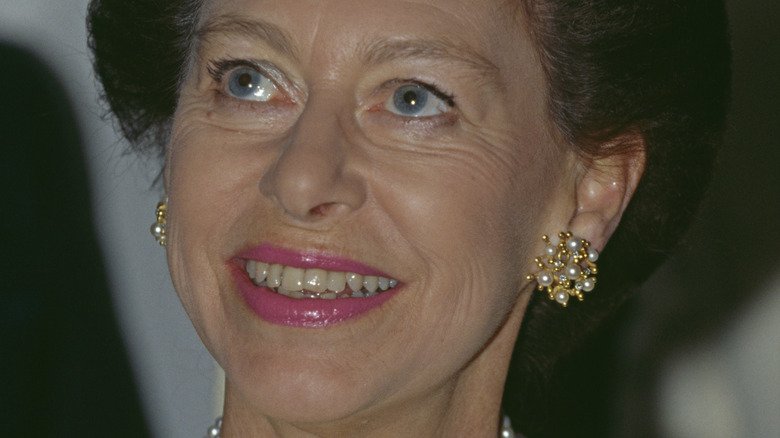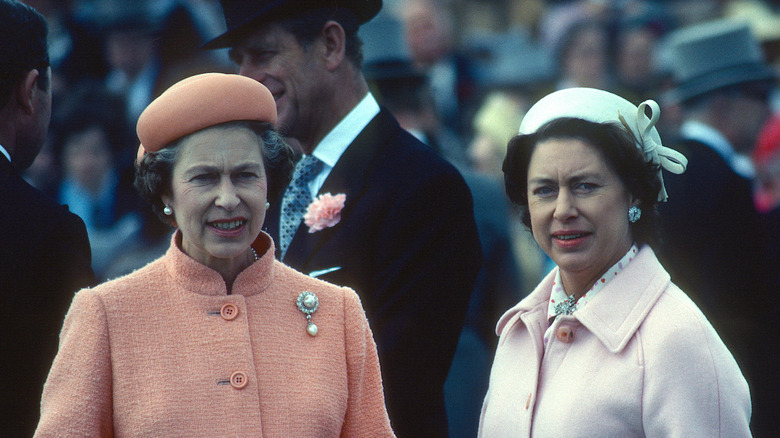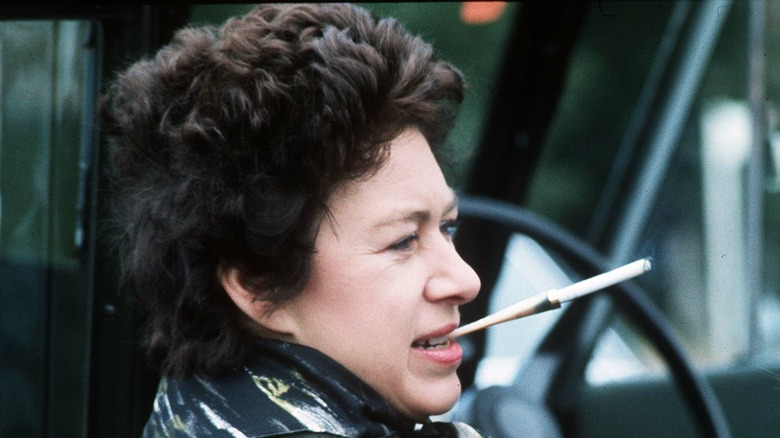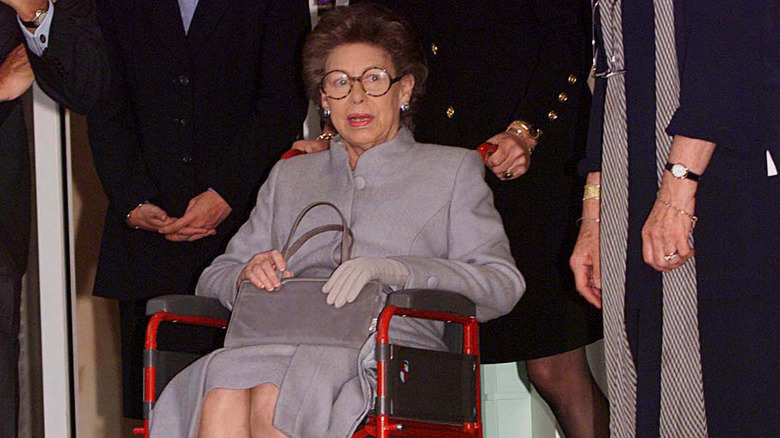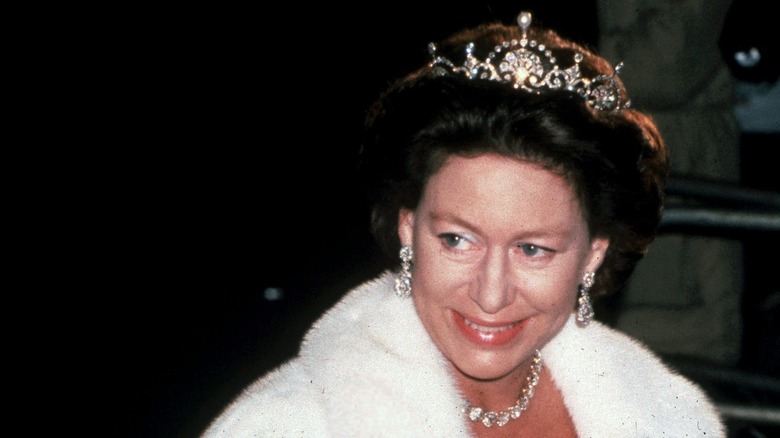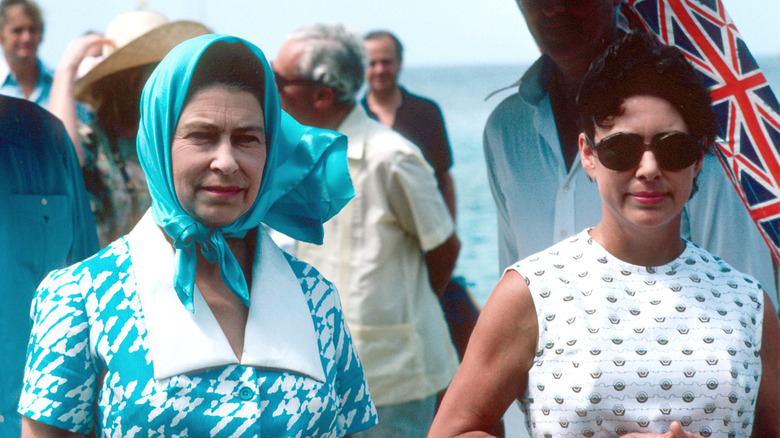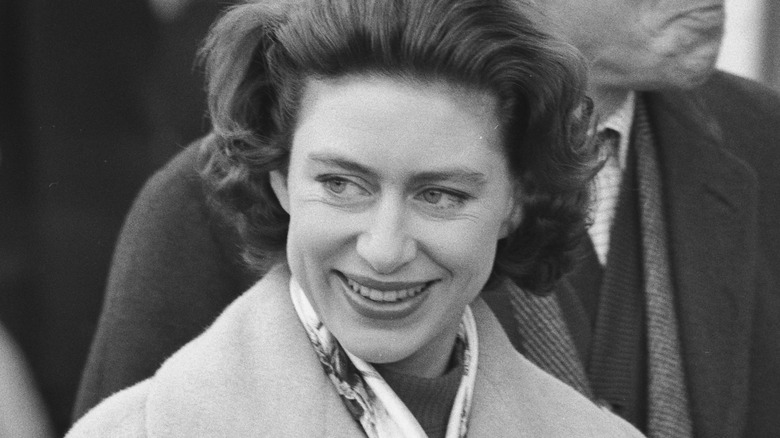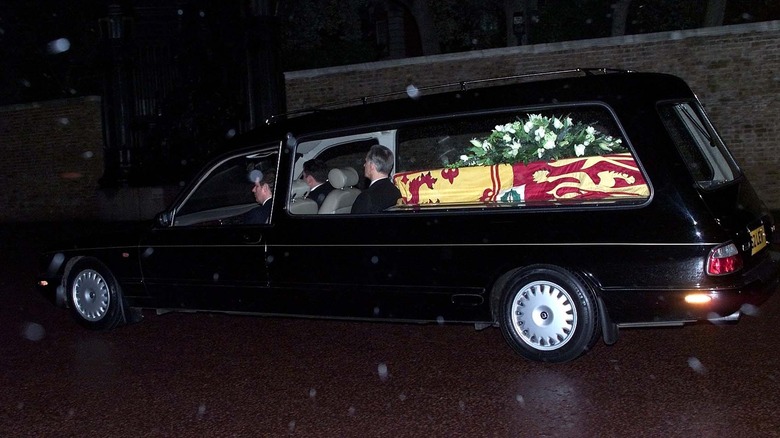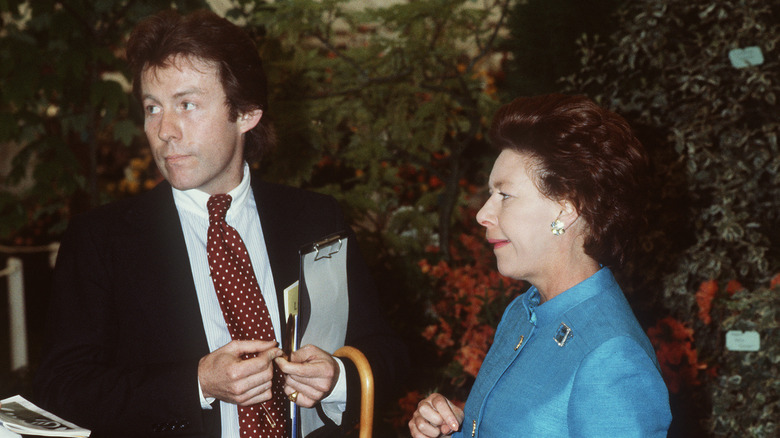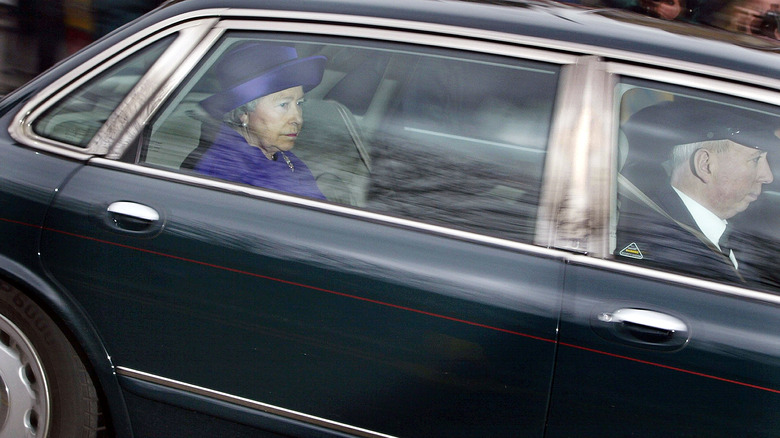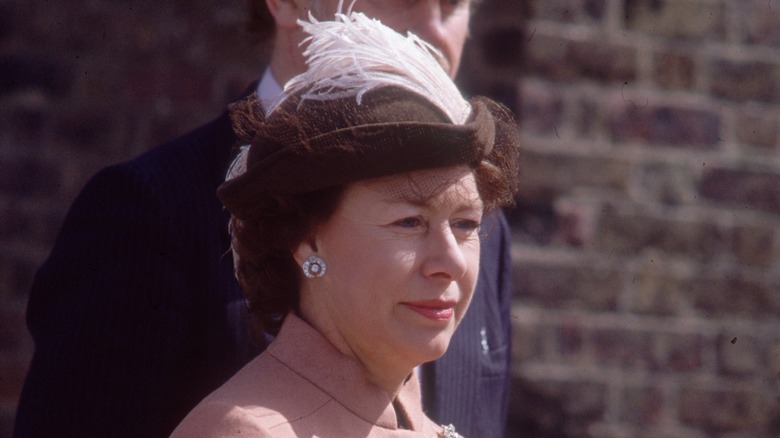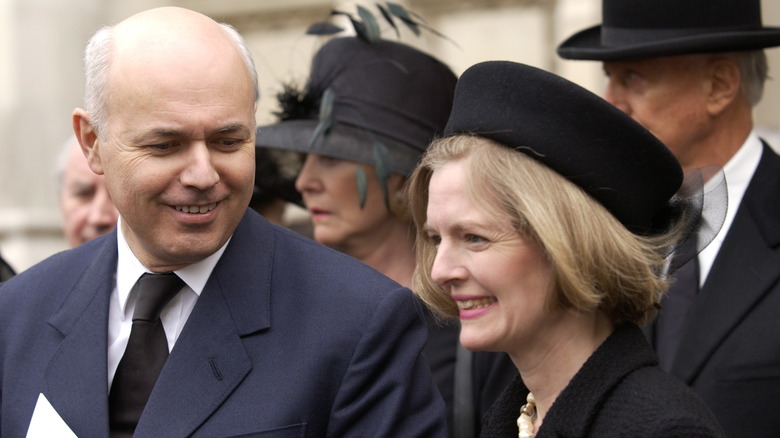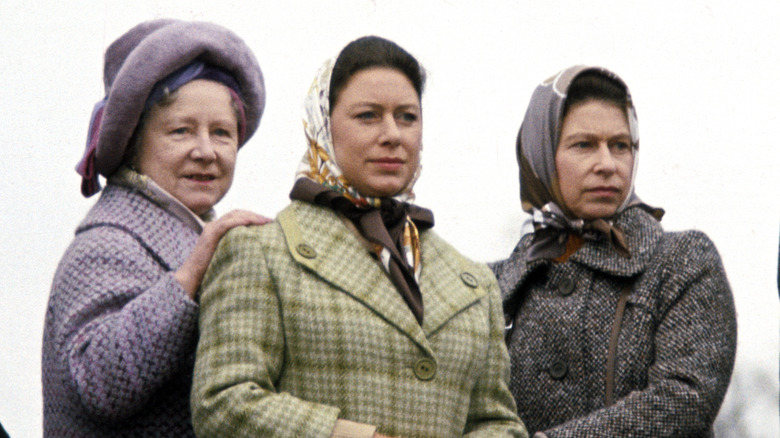Tragic Details About Princess Margaret's Death
Of all of the people in the late Queen Elizabeth's inner circle, perhaps none were as close to her as her younger sister, Princess Margaret. The two princesses grew up together and found themselves thrust in the public eye in 1936 when their uncle, Edward VIII, abdicated, making their father the king of England and Elizabeth the heir presumptive to the throne.
Born on August 21, 1930, Princess Margaret was known for her headstrong demeanor, which led to scandalous relationships and a reputation as something of a royal rebel and party girl (via Biography). However, as The Telegraph once wrote, "For all her brash insouciance and imperious tendencies, Margaret was insecure, her hauteur a compensation for her feelings of inadequacy."
The princess also shared a close bond with her sister, despite being the royal "spare" to the throne. "She was terribly loyal to the Queen — and being five years younger, I think it would have been much more difficult if she had been just [a little] younger than the Queen," Margaret's friend, Lady Anne Glenconner, told People. "There would have been more rivalry. She never said anything." The close bond between the two sisters lasted until Princess Margaret's tragic death in 2002.
She died in her sleep
Princess Margaret's death on February 9, 2002, was announced by Queen Elizabeth II's press secretary in a statement that began: "The Queen, with great sadness, has asked for the following announcement to be made immediately." The announcement stated that Margaret died at 6:30 a.m., noting that she went peacefully in her sleep. She was 71 years old.
Princess Margaret was hospitalized at The King Edward VII Hospital at the time of her death, having been brought there a few hours earlier due to a stroke she had the previous day. The stroke then led to heart problems, the statement explained.
The presence of Margaret's children, Lord Linley and Lady Sarah Chatto, at the time of her death suggests that the family was aware of the seriousness of Margaret's health complications. While Queen Elizabeth was not present at the time of her sister's death, the statement revealed, "The Queen was kept fully informed throughout the night."
She'd had strokes before
The stroke that led to Princess Margaret's death was not the first stroke she had experienced. Four years earlier, while on vacation in Mustique, she had a mild stroke. The Independent reported at the time that she was flown to Barbados for treatment, with a spokesman for the island of Mustique saying, "She was able to walk from her car across the Tarmac to the plane. She was also sitting on the plane, there was no need for a stretcher."
The outlet speculated that Margaret's chain-smoking — at one point in her life, she smoked as many as 60 cigarettes a day — could have contributed to the health scare, as smoking is known to increase the risk of stroke. While the princess had given up smoking by the time of her first stroke, she reportedly began smoking at the tender age of 15. According to People, she was also a heavy drinker for much of her life — another risk factor for stroke.
According to the official website of the royal family, Princess Margaret suffered two additional strokes before her death, one in 2000 and another in 2001.
She had been in poor health for a while
In the years leading up to her death, Princess Margaret was in poor health. Her obituary in The Guardian said she'd had pneumonia in 1993, while her first stroke in 1998 led to a slight speech impediment. The following year, she sustained severe burns on her feet in what the royal family's official website described as "a bathroom accident." The incident left her severely injured and made walking difficult. According to Biography, she made few public appearances after that and, when she did, she was seen in a wheelchair.
Princess Margaret also reportedly experienced depression in the 1970s, with The Guardian saying that she sought psychiatric treatment for it. While there were reports that she had another bout with depression at the turn of the millennium, this was denied by official royal sources. It should be noted, though, that the royal family was reticent about mental health issues at that time. Royal biographer Andrew Morton said that they offered her little support for her mental health.
"Let's face it, Margaret had depression and in the Royal Family you are not allowed to be depressed," he wrote in "Elizabeth & Margaret: The Intimate World of the Windsor Sisters" (via Woman & Home). He added, "They lived in a world where illness was dealt with by going for a long walk — and mental illness was ignored."
If you or someone you know needs help with mental health, please contact the Crisis helpline at 1-800-950-NAMI (6264), or visit the National Institute of Mental Health website.
The royal family asked mourners to dedicate to some of the causes she supported
In her life, Princess Margaret championed many causes. According to the royal family's website, more than 80 organizations boasted the royal's involvement. Some of her favorites were highlighted after her death, with the family asking mourners wishing to honor the princess with donations to the National Society for Prevention of Cruelty to Children (NSPCC), The Guide Association, and the Royal Ballet, as Princess Margaret was a patron of these groups.
Princess Margaret's association with The Guide Association, in particular, was a lengthy one. Girlguiding — the U.K. equivalent of the Girl Scouts — was something both Princess Margaret and Queen Elizabeth had long been involved in. "Her Majesty The Queen had a long association with Girlguiding throughout her life," the organization revealed. "She first joined Guides in 1937 at the age of 11, alongside her sister Princess Margaret, who joined Brownies." According to UPI, Princess Margaret served as the president of the Girl Guides Association and was awarded its highest honor, the Silver Fish, in 1968.
Mourners expressed their condolences in a modern way
Many people were heartbroken over the death of Princess Margaret. A memorial website was set up for her, and mourners wanting to offer their condolences were asked to email them in. Those wishing to pay their respects in person were invited to write in the condolence books set up at St. James's Palace.
One mourner, Barbara Girelli-Kent, signed the condolence book and told the press, "Princess Margaret was of my era in the 1960s. She was symbolic of correctness, strength of character, and she had a mind of her own but great respect for her majesty the queen and the royal institution. She was a trooper" (via CNN).
Another member of the public, Anthea Mander Lahr, said of the late royal, "She was a colorful character, not much older than myself, added a bit of spice to life with her scandals. It's such a nationalistic thing to say, but it gives you pride of being British."
Her death briefly brought together people of different politics
In addition to the outpouring of condolences from the public, there were also many public tributes to the late royal, per The Guardian. Her nephew, King Charles III, was said to be saddened by her death. Similarly, then-Prime Minister Tony Blair said, "I'm deeply saddened to hear of the death of Princess Margaret. My thoughts are with the queen, Queen Elizabeth the Queen Mother and the rest of the royal family at this time."
The death of Princess Margaret seemed to unite — if only temporarily — members of opposing political parties. "An active member of the royal family and a strong servant of her country, she will be sorely missed," said Conservative party member Iain Duncan Smith. "Our deepest sympathy and condolences go to Her Majesty the Queen, the Queen Mother and the rest of the royal family at this sad time." Liberal Democrat leader Charles Kennedy said, "I was very sad to hear of the death of Princess Margaret. We all suffer when we lose a close relative and I offer the Queen, the Queen Mother and the Royal Family my greatest sympathy."
While many spoke of Princess Margaret's rebellious nature and her scandal-ridden life, her cousin, Lady Elizabeth Shakerley, protested the press depicting her in that way (via CNN). "I think a troubled princess is a sad way to describe her," she said. "She lived life to the full, and she was such a fun person. She had a great capacity for making people laugh and making a situation wonderful."
Princess Margaret's funeral was held on the 50th anniversary of her father's burial
While the death of a beloved member of the royal family is often marked by a large, state funeral, Princess Margaret did not want such fanfare when she was laid to rest. Instead, she requested to have a private funeral, which was only attended by her relatives and people who'd been close to her. An official period of royal mourning was declared on February 9, the day of her death, and lasted until her funeral on February 15, per the royal family's website.
While the funeral was private, it was nevertheless quite a large affair. CNN reported that there were nearly 500 people present at the service at Windsor Castle's St. George's Chapel, a crowd that included family, friends, and members of her staff. In a strange twist of fate, Princess Margaret's funeral was held on the 50th anniversary of her father, King George VI's, own burial.
A controversial figure was invited to her funeral
Among the select list of mourners invited to attend Princess Margaret's private funeral were her ex-husband, Antony Armstrong-Jones, Earl of Snowdon, and even her ex-boyfriend, Roddy Llewellyn, as noted by CNN.
Llewellyn was a subject of fascination to the press during his relationship with the princess, much to the consternation of the royal family. According to the BBC, the two met in 1973 while she was still married to the earl. Once the news of her affair broke, a scandal erupted and her marriage ended. Princess Margaret became the first member of the royal family to divorce in hundreds of years, the last royal to do so being King Henry VIII, who infamously created the Church of England in the 16th century in order to divorce his first wife, Catherine of Aragon, to marry Anne Boleyn. Adding to the scandal, per Evening Standard, was the fact that Llewellyn was in his 20s when the couple became involved — 17 years younger than Margaret herself. The relationship lasted eight years, until Llewellyn broke up with the princess to marry someone else. According to Vanity Fair, Margaret remained on good terms with Llewellyn and his bride.
Margaret's friend, Lady Anne Glenconner, said in the documentary "Elizabeth: Our Queen" (via Daily Mail) that Queen Elizabeth approached her after Margaret's funeral to thank her for introducing the couple. "'I'd just like to say Anne, it was rather difficult at moments, but ... he made her really happy,'" she recalled the queen saying.
Queen Elizabeth lost her composure at her sister's funeral
The British royal family is known for keeping a "stiff upper lip," no matter how tough things get. Princess Margaret and her sister were quite close, though, and her death devastated the monarch. She expressed her heartbreak stoically in the public announcement of Margaret's death, which mentioned her "great sadness," but her actions at the private funeral held for Princess Margaret showed just how distraught she really was over losing her sister.
Princess Margaret's friend, Princess Josephine Loewenstein, said in the documentary "Elizabeth: Our Queen" (via Women & Home), that Margaret told her she'd only seen Elizabeth cry once in their entire lives. Tears were rare for the queen, but she lost her composure at Margaret's funeral, crying in front of everyone.
"I think it was the only time anyone ever saw the Queen show her emotions in public," wrote Reinaldo Herrera, a friend of the royal family, in Vanity Fair. "Never explaining anything to the world — what she feels, or why she does what she does — is part of her greatness. But for a few minutes that day, as she stood by the steps of St. George's Chapel at Windsor Castle, watching her sister's coffin being borne away, her eyes betrayed her."
She may have requested to be cremated to 'be with the late King'
In another break with royal tradition, Princess Margaret asked to be cremated rather than buried. While there is no official ban on royal cremation, The Scotsman reported at the time that it was believed no member of the royal family had been cremated in decades, since Queen Victoria's daughter, Princess Louise, Duchess of Argyll, died in 1939.
Princess Margaret's friend, Lady Anne Glenconner, said that Margaret did not want to be buried at the royal burial ground at Frogmore, saying, "She told me that she found Frogmore very gloomy." Instead, her ashes were laid to rest at the Royal Crypt at St George's Chapel, the final resting place of her father, King George VI. "I think she'd like to be with the late King, which she will now be," said Glenconner.
Glenconner explained in the documentary "Elizabeth: Our Queen" that there was no space for her coffin in the chapel, which is why Princess Margaret decided to be cremated rather than buried. "There was only room, really, for ashes," she said.
She helped plan her own memorial service
While Princess Margaret had a private funeral, a public memorial service was held for everyone else who wanted to mourn her death. "I think she wanted her family and her friends at her funeral," her friend, Lady Anne Glenconner, told The Scotsman ahead of the service. "Obviously, later on there will be a memorial service when her charities will be represented, but for her actual funeral she wanted it to be as private as possible."
The memorial service was held at noon on April 19, 2002, at Westminster Abbey. The program for the event reveals that Princess Margaret had a hand in planning it. "The service is set around the Requiem by Gabriel Fauré (1845-1924) in accordance with the wishes of Her Royal Highness The Princess Margaret, Countess of Snowdon," reads the program, which also reveals that she handpicked the choirs that sang at the service.
According to CBC, the memorial service was well attended. In addition to her family, then-Prime Minister Tony Blaire was in attendance. Her ex-husband was also present, as was her former boyfriend, Roddy Llewellyn. Roughly 2,000 mourners in total came to pay their respects to the late princess.
The royal family suffered back-to-back tragedies
Princess Margaret's death was already a huge blow to the royal family, but her death was soon followed by another loss for the royals. Princess Margaret and Queen Elizabeth II's mother, also named Elizabeth, died the following month, on March 30, 2002.
"The Queen, with the greatest sadness, has asked for the following announcement to be made immediately: her beloved mother, Queen Elizabeth, died peacefully in her sleep this afternoon at Royal Lodge, Windsor. Members of the royal family have been informed," said Buckingham Palace in a statement (via The Guardian). She was 101 years old and had been ill for some time, having had a chest infection in December, but was still adamant about attending Princess Margaret's funeral, historian Hugo Vickers said in the documentary "Elizabeth: Our Queen." Lady Anne Glenconner added, "The Queen Mother was in a wheelchair, and when the coffin went by she tried to stand up, or I think she may have been held up, so she could be standing when Princess Margaret's coffin went by."
The back-to-back tragedies marked a difficult time for the royal family, especially as Princess Margaret's memorial service was held just 10 days after her mother was laid to rest, per CBC.
